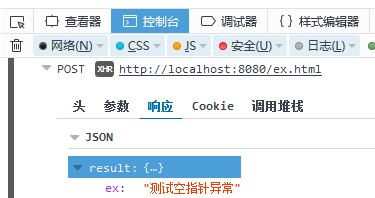1. 文件上传
SpringMVC 的文件上传非常简便,首先导入文件上传依赖的 jar:
1 <!-- 文件上传所依赖的 jar 包 --> 2 <dependency> 3 <groupId>commons-fileupload</groupId> 4 <artifactId>commons-fileupload</artifactId> 5 <version>1.3.1</version> 6 </dependency>
在 springMVC-servlet.xml 配置文件中配置文件解析器:
1 <!--1*1024*1024 即 1M resolveLazily 属性启用是为了推迟文件解析,以便捕获文件大小异常 2 --> 3 <!--文件上传解析器--> 4 <bean id="multipartResolver" 5 class="org.springframework.web.multipart.commons.CommonsMultipartResolver"> 6 <property name="maxUploadSize" value="1048576"/> 7 <property name="defaultEncoding" value="UTF-8"/> 8 <property name="resolveLazily" value="true"/> 9 </bean>
注意解析器的 id 必须等于 multipartResolver,否则上传会出现异常:
1.1 单个文件上传
1 @Controller 2 public class FileController { 3 /** 4 * 上传单个文件操作 5 * MultipartFile file 就是上传的文件 6 * @return 7 */ 8 @RequestMapping(value = "/upload1.html") 9 public String fileUpload1(@RequestParam("file") MultipartFile file) { 10 try { 11 //将上传的文件存在 E:/upload/下 12 FileUtils.copyInputStreamToFile(file.getInputStream(), 13 new File("E:/upload/", 14 file.getOriginalFilename())); 15 } catch (Exception e) { 16 e.printStackTrace(); 17 } 18 //上传成功返回原来页面 19 return "/file.jsp"; 20 } 21 }上传文件时,Controller 的方法中参数类型是 MultipartFile 即可将文件映射到参数上。
页面file.jsp:
1 <form method="post" action="/upload1.html" enctype="multipart/form-data"> 2 <input type="file" name="file"/> 3 <button type="submit" >提交</button> 4 </form>
另外上传的文件还可以映射成 CommonsMultipartFile,它是 MultipartFile 的子类:
1 /** 2 * CommonsMultipartFile 是 MultipartFile 的子类 3 * @return 4 */ 5 @RequestMapping("/upload2.html") 6 public String fileUpload2(@RequestParam("file") CommonsMultipartFile file) { 7 try { 8 System. out .println("fileName:" + file.getOriginalFilename()); 9 String path = "E:/upload/" + file.getOriginalFilename(); 10 File newFile = new File(path); 11 //通过 CommonsMultipartFile 的方法直接写文件 12 file.transferTo(newFile); 13 } catch (Exception e) { 14 e.printStackTrace(); 15 } 16 return "/file.jsp"; 17 }
页面:
1 <form method="post" action="/upload2.html" enctype="multipart/form-data"> 2 <input type="file" name="file"/> 3 <button type="submit" >提交</button> 4 </form>
1.2 批量上传
1 /** 2 * 批量上传的时候参数是数组 3 * @return 4 */ 5 @RequestMapping("/upload3.html") 6 public String fileUpload3(@RequestParam("file") CommonsMultipartFile[] file) { 7 try { 8 //批量上传时遍历文件数组 9 for (CommonsMultipartFile f : file) { 10 System. out .println("fileName:" + f.getOriginalFilename()); 11 String path = "E:/upload/" + f.getOriginalFilename(); 12 File newFile = new File(path); 13 f.transferTo(newFile); 14 } 15 } catch (Exception e) { 16 e.printStackTrace(); 17 } 18 return "/file.jsp"; 19 }
页面:
1 <form method="post" action="/upload3.html" enctype="multipart/form-data"> 2 <!--注意 name 都是 file,与 Controller 中方法的参数名对应--> 3 <input type="file" name="file"/> 4 <input type="file" name="file"/> 5 <input type="file" name="file"/> 6 <button type="submit" >提交</button> 7 </form>
2. 使用拦截器
模拟登陆拦截器:
1 public class LoginInterceptor extends HandlerInterceptorAdapter { { 2 @Override 3 public bo olean preHandle(HttpServletRequest request, HttpServletResponse response, 4 Object handler) throws Exception { { 5 System. out .println(" " 开始拦截" "); 6 // 其他情况判断 n session 中是否有 key ,有的话继续用户的操作 7 if ( request. getSession(). getAttribute( "user") != null) { { 8 return true; 9 } } 10 // 最后的情况就是进入登录页面 11 response. sendRedirect( request. getContextPath() + "/login.jsp"); 12 return false; 13 } } 14 @Override 15 public void postHandle(HttpServletRequest request, HttpServletResponse response, 16 Object handler, ModelAndView modelAndView) throws Exception { { 17 System. out .println(" " 视图解析前 postHandle"); 18 } } 19 @Override 20 public void afterConcurrentHandlingStarted(HttpServletRequest request, 21 HttpServletResponse response, Object handler) throws Exception { { 22 System. out .println(" " 处理异步请求" "); 23 } } 24 } }
配置拦截器:
扫描二维码关注公众号,回复:
3138812 查看本文章


1 <mvc:interceptors> 2 <mvc:interceptor><!--配置局部拦截器,需要满足下列路径条件--> 3 <mvc:mapping path="/**"/> 4 <mvc:exclude-mapping path="/login.html" /> 5 <bean class="interceptor.LoginInterceptor"/><!--自定义拦截器注册--> 6 </mvc:interceptor> 7 </mvc:interceptors>
登陆的 Controller
1 @Controller 2 public class LoginController { { 3 @RequestMapping( "login.html") 4 public String login( String username, HttpServletRequest request){ { 5 // 模拟登陆 6 request. getSession(). setAttribute( "user", username); 7 return "redirect:index.html"; 8 } } 9 } }
登陆页面:
1 <form action="/login.html"> 2 <input name="username"/><input type="submit"> 3 </form>
3. 异常处理
3.1 集成异常处理
对 于 一 些 通用 的 ,不 需 要特 殊 处 理的 异 常,可 以 使 用统 一 的 异常 处 理器 , 在springMVC-servlet.xml 中加入配置:
1 <!--集成异常处理--> 2 <bean 3 class="org.springframework.web.servlet.handler.SimpleMappingExceptionResolver"> 4 <!-- 定义默认的异常处理页面--> 5 <property name="defaultErrorView" value="error.jsp"></property> 6 <!-- 定义异常处理页面用来获取异常信息的变量名,默认名为 exception --> 7 <property name="exceptionAttribute" value="ex"></property> 8 <!-- 定义需要特殊处理的异常,用类名或完全路径名作为 key,异常也页名作为值 --> 9 <property name="exceptionMappings"> 10 <props> 11 <prop key="java.lang.NullPointerException">error.jsp</prop> 12 <prop key="java.lang.ClassCastException">error.jsp</prop> 13 <prop key="java.lang.IndexOutOfBoundsException">error.jsp</prop> 14 <!-- 这里还可以继续扩展对不同异常类型的处理 --> 15 </props> 16 </property> 17 </bean>
我们写一个 controller 专门抛出异常,用来模拟程序中可能出现的异常信息:
1 @Controller 2 public class ExceptionController { 3 @RequestMapping("/ex.html") 4 public String exceptionTest(Integer type) throws Exception { 5 //手动抛出几个异常,模拟程序中可能出现的异常 6 switch (type) { 7 case 1: 8 throw new NullPointerException("测试空指针异常"); 9 case 2: 10 throw new ClassCastException("测试类型转换异常"); 11 case 3: 12 throw new IndexOutOfBoundsException("测试越界异常"); 13 } 14 return "index.jsp"; 15 } 16 }
测试页面:
1 <body> 2 <a href="/ex.html?type=1">空指针</a><br/> 3 <a href="/ex.html?type=2">类型转换</a><br/> 4 <a href="/ex.html?type=3">越界</a><br/> 5 ${ex}<!--就是 spring 异常处理器中配置的 exceptionAttribute--> 6 </body>
运行结果:

点击不同的链接可以看大不同的提示信息。
3.2 自定义异常处理
对于需要特殊处理的异常,可以自定义异常处理器自定义异常处理的类需要继承 HandlerExceptionResolver
1 public class MyExceptionHandler implements HandlerExceptionResolver { { 2 @Override 3 public ModelAndView resolveException(HttpServletRequest httpServletRequest, 4 HttpServletResponse httpServletResponse, Object o o, Exception e e) { { 5 String msg = e e.getMessage(); 6 httpServletRequest. setAttribute( "ex", msg); 7 return new ModelAndView( "/error.jsp"); 8 } } 9 } }
在 spring 配置文件中定义 bean:
1 <!--自定义异常处理--> 2 <bean id="exceptionHandler" class="exception.MyExceptionHandler"/>
注:自定义异常处理和前面的集成异常处理不能一起使用,需要将 前面例子的 bean 注释掉。如果需要处理 ajax 发送的请求,出现异常时返回 json 数据,可以增加处理 json 的代码。
修改 MyExceptionHandler 中的代码:
1 public class MyExceptionHandler implements HandlerExceptionResolver { 2 @Override 3 public ModelAndView resolveException(HttpServletRequest httpServletRequest, 4 HttpServletResponse httpServletResponse, Object o, Exception e) { 5 String msg = e.getMessage(); 6 if (httpServletResponse.isCommitted()) { 7 return null; 8 } 9 //如果是 ajax 请求就返回 json 数据 10 if (isAjax(httpServletRequest)) { 11 Map<String, String> result = new HashMap<>(); 12 result.put("ex", msg); 13 MappingJackson2JsonView view = new MappingJackson2JsonView(); 14 return new ModelAndView(view, "result", result); 15 } else {//不是 ajax 就返回错误页面 16 httpServletRequest.setAttribute("ex", msg); 17 return new ModelAndView("/error.jsp"); 18 } 19 } 20 public static boolean isAjax(HttpServletRequest request) { 21 return 22 "XMLHttpRequest".equalsIgnoreCase(request.getHeader("X-Requested-With")) || 23 request.getParameter("ajax") != null; 24 } 25 }
测试页面:
1 <script type="text/javascript" src="jquery-1.10.1.min.js"></script> 2 <input type="button" onclick=" testEx ()" value="测试自定义异常"/> 3 <script type="text/javascript"> 4 function testEx (){ 5 $.ajax({ 6 type: "POST", 7 url: "/ex.html?type=1", 8 success: function(data){ 9 alert(data.result.ex);//读取 json 数据 10 } 11 }); 12 } 13 </script>
测试结果:
